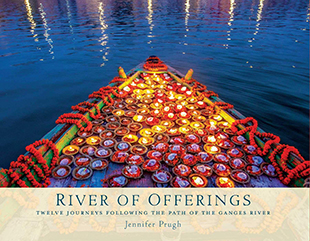"The Ganges River begins at Gangotri Glacier in the Indian state of Uttarakhand in the central Himalayas and flows southeast into the Bay of Bengal through a vast delta in the Sundarbans. A lifeline for nearly six hundred million people, the river has been revered among Hindus for several thousand years. It is worshipped in its personified form as the celestial goddess Ganga, who flows across the sky as the Milky Way and then fiercely spills down from heaven through the god Shiva's matted hair. Ganga is known as a medicine for any ailment; she purifies and cleanses sin; and for those whose ashes are entrusted to her waters, she releases souls from the cycle of life and death. She is unique, like you, and like you, she shares the same basic qualities of all the world's rivers.
"The life of a river is often viewed in three stages: those of a "young," a "middle-aged," and an "old" river. When a river begins, droplets originate from clouds or glaciers. Through repetition, each drop mirrors the last, trickling, dripping, pooling and spilling, and eventually coalescing, until they pour forth, becoming rivulets, creeks, and streams. The more water merges, the more force it has. Waterfalls and rapids may form. In 2009, when these journeys to India began, like a water drop propelled by momentum, they were compelled by my desires to learn more about the origins of Eastern spiritual practices, or the yoga that was introduced to me as a child. The Ganges River was the last thing on my mind.
"Once a river becomes a channel, its route is set, and it moves into middle age. With little to threaten its path, except for storms, it slows down enough to receive other bending, curving, and snake-like tributaries and forms meanders. In the winter of 2013, I traveled to India to the Kumbh Mela, the largest gathering of humanity in the world, where, for centuries, a variety of spiritual tributaries have converged in Allahabad at the meeting of the Ganga, Saraswati, and Yamana Rivers. I discovered that while each teacher, guru, and sect has its own prismatic lens through which to view spiritual life, what virtually everyone I met confirmed is that the Ganga is sacred. I wanted to experience what it was like to have a spiritual relationship with a force of nature. To "widen my aperture," I set out toward the Himalayas to photograph Ganga's source, and then eastward, where she empties out to Kolkatu. I wanted to know this river from beginning to end.
"Over the next four years, I saw Ganga shrouded in fog, blanketed in smoke, smog, and haze, in the blue hour before dawn, and in the golden hour at dusk. I saw her turn milk chocolate brown in raging storms, host swarms of mosquitoes, and graciously escort corpses to the sea. I watched as she received bathers, offerings of flowers and fruit, sacred books, plastic trash, toxins from tanneries, and excrement, all the while taking on the sins of seven percent of humanity.
"By the time a river becomes old, its estuaries have fed many living creatures. Its twists and turns have eroded and her surface has become smooth. Like an elder, the river no longer moves as quickly as she did in her youth. With a shallower gradient and forming floodplains and deltas, she becomes less fresh, more salty. The final few chapters of this book are journeys to where the Ganga becomes the sea, out of which come observations about what can be learned from this river.
"These are stories about what I learned on a series of pilgrimages to significant locations along the Ganga in a variety of vehicles -- planes, trains, automobiles, buses, motorized and cycle rickshaws, and boats, and on elephants and camels -- and in shoes and with bare feet. It is also the photographic chronicle of what I have seen looking through the viewfinder of a camera.
"I'm not a scholar, a historian, or a National Geographic photographer. I'm a practitioner and teacher of yoga from California who went to India to deepen my spiritual understanding. This has happened, but certainly not in the way I imagined. Unlike the few who have walked the river from end to end, my journey over a ten-year period has been to one section of the river at a time. I am also a mother and a yoga studio owner in California's Silicon Valley, so each trip to India, or to Ganga's tributaries in Nepal or Tibet, lasted no longer than a month at a time. I do not speak Hindi or Bengali or read Sanskrit. I have relied on a loyal and courageous travel guide, an American-size suitcase, eye contact, extra batteries, the kindness of strangers, and faith to make this possible. What began as a search to deepen my yoga practice became a love affair with this river -- and all bodies of water, which deserve the reciprocal care and attention of those who turn to them for solace, sustenance, and redemption, as well as a search for how to live our lives in meaningful ways and to the very best of our abilities."
